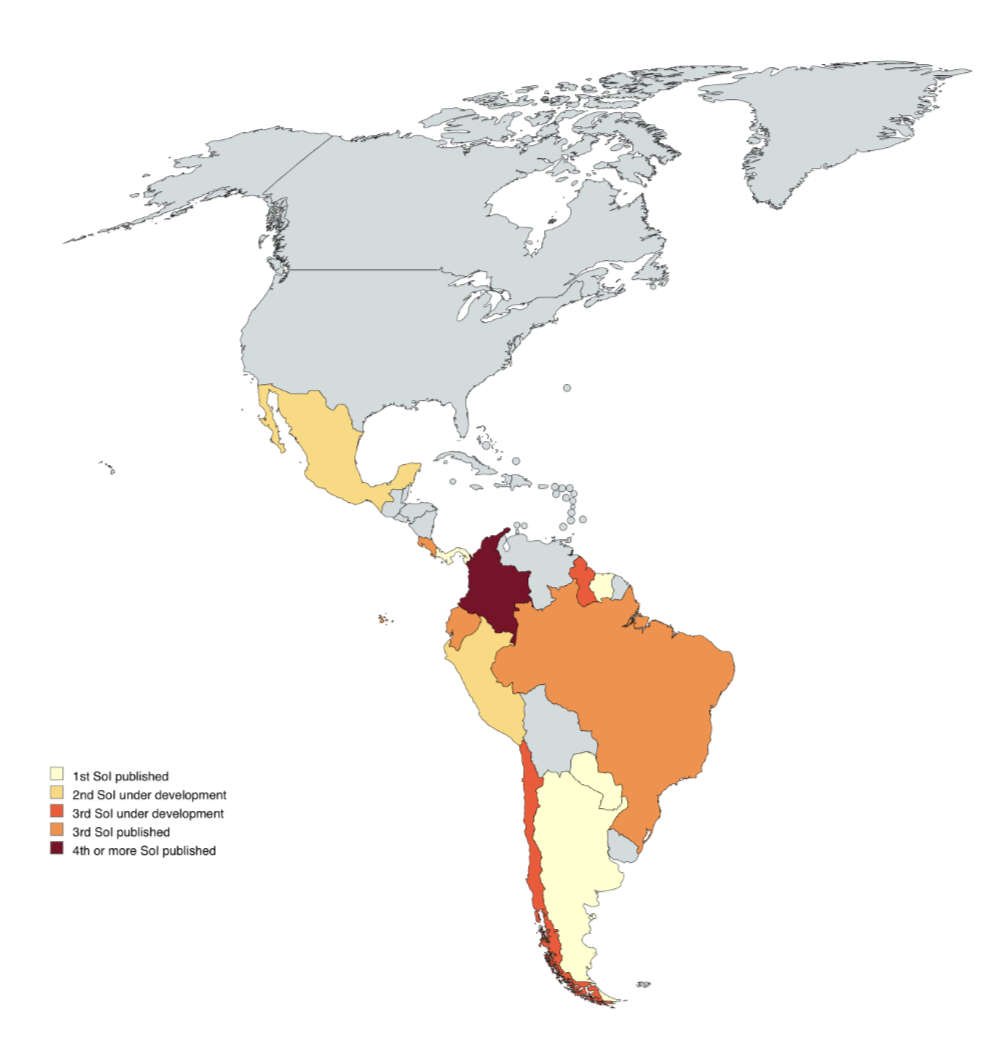A brief of the fourth session of the Working Group on Safeguards and Integrity for UN-REDD Programme in Latin America and the Caribbean.
Safeguards Information Summaries
As countries prepare to submit their Safeguards Information Summaries (Sol) - a vital component for REDD+ implementation and results-based payments - below are a few pointers and guidance to help smooth the process and provide greater clarity:
What are Safeguards Information Summaries?
A Safeguards Information Summary (SoI) is a document that provides an overview of how safeguards are being tackled and respected in a country, whether within the framework of the Cancun Safeguards (Decision 12/CP.19)1, other safeguard frameworks, or via national or jurisdictional priorities. These summaries include information on government policies, institutional measures taken, and actions implemented related to safeguards. According to the Warsaw REDD+ Frameworki, a SoI is a requirement to access REDD+ results-based payments within the context of the United Nations Framework Convention on Climate Change (UNFCCC).
The state of development, general challenges, and lessons learned from countries in the Latin America and Caribbean (LAC) region were the main topics addressed at the fourth session of the Working Group on Safeguards and Integrity for the UN-REDD Programme. A summary of the findings is provided below.
Sol review shows mixed progress, highlights challenges
During the fourth virtual session of the Working Group where more than 30 safeguards’ specialists from different countries in Latin America and the Caribbean participated, the current progress in Safeguards Information Systems (SIS) was reviewed. The analyzes, provided by UNEP’s safeguards specialists and inputs from the countries, focused on the countries that have submitted these reports at different stages and showed that the advances in SoI development in the LAC region varied.
According to this analysis, common challenges in SoI development included the complexity of presenting clear and understandable information for various stakeholders, incorporating data and information from the field, and reporting on indicators to monitor and evaluate compliance with the safeguards over time.
Based on aspects such as the state of REDD+ implementation, the maturity of national safeguards systems, regulatory frameworks, available budgets and others, country safeguard teams are approaching the challenge for drafting SoI in different ways.
Colombia is among the countries with most SoI published. The country is currently finalizing their sixth, which reports up to October 2021. Previous SoI were focused on the REM Program (REDD Early Movers), a national government initiative called "Amazon Vision," but more recently other REDD+ programs and initiatives were included in the report. Among the main challenges for this process has been coordinating between different departments of the Ministry of Environment, as well as consolidating information from different REDD+ projects and initiatives with multiple monitoring indicators into a single document, said María Alejandra Garzón Sánchez, former REDD+ focal point for the Climate Change Directorate of the Ministry of Environment of Colombia.
Among the countries preparing their second SoI, Alicia Albertos, from the Safeguards Team of Mexico´s National Forestry Commission (CONAFOR), said Mexico was concluding its second SoI, which relates to the National REDD+ Strategy .
Since 2010, Mexico has been developing its National REDD+ Strategy, with a focus on sustainable rural development and alignment to environmental and developmental agendas. During the process, the country has worked on updating safeguards compliance strategies, starting with evaluating the existing information on safeguards compliance at national and subnational levels. Then, they updated and expanded the information, engaging in interinstitutional dialogue with more public entities to enhance the available information.
At a similar stage in its process, Peru recently opened its second SoI draft for public consultation, which is likely to be presented to the UNFCCC later this year.
Chile is working on its third SoI. Valentina Rivera, national safeguards expert in National Forestry Corporation (CONAF), expressed that a major challenge was how to provide the necessary information without making the report too extensive and complex to the different stakeholders. The CONAF team’s experience had highlighted the need for practical and clear details with internal guiding principles developed specific for SoI updates, ensuring verification methods for greater reliability and striving to present statistical data to demonstrate the country's progress.
How does SoI work?
The UNFCCC sets out specific guidelines for the implementation of SoI, such as including detailed information on national circumstances and the national approach to safeguards. Guidelines outlined by the United Nations Framework Convention on Climate Change regarding the content of information summaries, includes the following pointers:
-
They should describe the specific REDD+ activities being undertaken.
-
They must outline the relevant national circumstances crucial for addressing and adhering to safeguards.
-
A detailed description of each safeguard tailored to national contexts is essential.
-
The summaries should explain the relevant systems and processes in place. Additionally, they should set out how each safeguard has been approached and respected.
-
Lastly, any other pertinent information relevant to the initiative should also be included.. UNFCCC establishes how often the summaries must be submitted -when initiating the implementation of REDD+ activities; and during the implementation of those activities, at least every four years.
It must be noted that in the case of SoI that are in advanced stages of the implementation of REDD+ strategies, such as Green Climate Fund projects, forests carbon schemes or, Memorandum of Understanding agreements, existing UNFCCC guidance may be insufficient for the challenges faced by country safeguards teams in preparing second, third or subsequent safeguard reports,”, said Mariano Cirone, the safeguards focal point at UNEP UN-REDD team in Latin America and the Caribbean (LAC).
Since UNFCCC guidance for SoI are more focused on the readiness, several LAC countries, especially those with REDD+ activities on the ground, are facing similar challenges when it comes to how to develop subsequent SoI. While these reports were more focused on legal and institutional frameworks during the REDD+ preparation phase to comply with the Warsaw Framework , now that many countries are more advanced in the implementation of REDD+, some of the main challenges lie in how to present information on “respecting” safeguards in a clear and concise manner, said Judith Walcott, coordinator of the UNEP UN-REDD team in LAC.
Final recommendations from the working group
The process of developing SoI is a crucial step in meeting the requirements of the UNFCCC Warsaw REDD+ Framework, and for being eligible for Results-based Payments from different donors and programs, which may request a SoI as a requirement. However, the complexity of reporting, the need for clarity, and the consolidation of information from various sources, poses significant challenges in their development. This is especially true in countries with many REDD+ activities being implemented on the ground, at different scales and with different approaches (i.e. GCF result-based payment programmes, voluntary carbon market projects and others).
Based on the exchange of this fourth session of the Working Group and in the experience of the UNEP’s Safeguards Team for the UN-REDD Programme in LAC, initial recommendations to improve clarity on SoI updates include:
-
Ensure clarity in language to enhance understanding.
-
Incorporate visual verification means to aid comprehension.
-
Combine narrative descriptions with quantitative data for a comprehensive overview.
-
Highlight advancements of the Safeguards Information System (SIS) to showcase progress.
-
Provide detailed insights into the development process of Sol to foster transparency.
-
Strengthen information on compliance by utilizing indicators and percentages, where applicable, to convey effectiveness.
-
In cases of REDD+ implementation at different scales and with different approaches, nested approach conceived with a broader scope might be needed, considering minimum requirements for SIS and safeguards report at different levels (i.e. subnational, program or projects), together with provision of carbon accounting and governance.
This article briefs the highlights of the fourth session of the Working Group on Safeguards and Integrity for UN-REDD Programme in Latin America and the Caribbean.
For further context on basic aspects of SoI, we suggest consulting:
-
Cordula E. et al. (2020). Summaries of Information: initial experiences and recommendations on REDD+ safeguards reporting (Spanish version)
-
UN-REDD Programme Safeguards Coordination Group. (February, 2017). Information Summaries: Ways to demonstrate that REDD+ safeguards are being addressed and respected. Information Note. (Spanish version)





